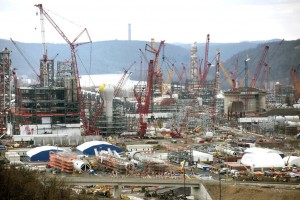From the Eyes On Shell Watchdog Team, Beaver County, PA, June 8, 2022
It was great to have many of you on the June 1st “Eyes On Shell Watchdog Team” Zoom meeting! Thanks for participating because watching Shell closely is especially important now.
As discussed at the meeting, we expect Shell’s cracker to be starting up in phases over the next few months and as early as July. During startup, before the plant comes fully online (by late 2022 or early 2023, according to Clean Air Council), we can expect significant emissions.
We can’t predict exactly the amount or timing of startup emissions. Emissions during Startup, Shutdown and Maintenance may be slightly greater than when they are running in a Steady State, but they still cannot exceed their Total Permitted Amount without incurring an infraction. We have examined the list of chemicals permitted as emissions and how much of each Shell can release during the year.
For the June 1st meeting, many thanks go to Rachel Meyer for her “Health Impacts of Oil and Gas Infrastructure” presentation. Rachel posted the following related links:
>>> The Fractracker Threat Map allows you to see how close you live to oil and gas facilities, and at Fractracker.org you can find out more about the organization that creates so many good maps.
>>> The National Energy and Petrochemical Map shows just how many pipelines there are across the whole country.
Rachel Meyer closed with this comment: Thank you for listening to my presentation! I would love to hear from you. Rachel Meyer ~ rmeyer@momscleanairforce.org
Terrie Baumgardner, who works with Clean Air Council (CAC) as Outreach Coordinator for Beaver County, closed the meeting with a preview of CAC’s Good Neighbor Wishlist. As we approach the point when the cracker will start turning fracked gas into 1.6 million metric tons of plastic pellets per year, Clean Air Council is asking residents to urge Shell to justify its claim of being a “good neighbor” by doing more to protect the community than what is legally required. The specific steps that residents, starting with EOS participants, can ask Shell to take are summed up in the Wishlist–a scaffolding for actions to discuss in future meetings.
Terrie also asks this of EOS participants: Please contact me if you live within a few miles of the plant and would like to find out more about hosting a PID (Photoionization Detector) for air sampling during a malodor event like the September 2021 maple-syrup smell one in Beaver. Her email is ~ tbaumgardner@cleanair.org.
A really good, wide-ranging discussion facilitated by Dr. Cliff Lau included information about Beaver County’s Local Emergency Preparedness Committee (LEPC) and an appeal to participants to attend the quarterly LEPC meetings.
We are also looking for someone to host a Breathe Cam, which will help us watch for emissions from different parts of the Shell petrochemical facility so we can better understand what is in our air.
Aerial photographer and blogger Bob Donnan was a great contributor to the June 1st meeting. For Bob’s remarkable weekly selection of petrochemical alerts and images, please see here.
Before our next EOS meeting on Wednesday, July 6, we need to begin to pull together your journaling observations. We’re also getting ready to train participants for and to place both monitors and bucket air samplers. If you’re a Watchdog Team member who has completed our surveys and indicated your interest in hosting, you will be contacted about next steps.
Our next Eyes On Shell Watchdog Team meeting will be in early July.
>>> Nora Johnson, Secretary, Beaver County Marcellus Awareness Community (BCMAC)


{ 1 comment… read it below or add one }
Westmoreland Marcellus Citizens’ Group
From Jan Milburn, WMCG, June 13, 2022
Shell Cracker Will Produce Nurdles for Plastic from the Ethane from Fracking
Environmentnal Groups Begin Monitoring the River; Universities Lend Expertise to Analyze
“Shell plans to begin operations this summer at its new industrial complex along the Ohio River in Beaver County. The plant will use ethane produced at the region’s gas wells to make tiny polyethylene plastic pellets, which some people call nurdles.
They’re used to make many kinds of plastic products.
But nurdles can also end up in waterways, which is why environmental groups, working with local researchers, have started searching for nurdles in the water near the plant. They’re trying to establish a baseline of what’s in the Ohio now, and will continue to survey the river after the plant opens, so they can tell if nurdles from the plant are getting into the river.
Nurdles are the size of a lentil. They’re the raw material used by manufacturers to make other plastic products. It takes more than 350 nurdles for one yogurt cup, and over a thousand nurdles to make a soda bottle.
When Shell’s multi-billion dollar ethane cracker opens, it will produce 1.6 million metric tons of plastic pellets a year.
Fish and birds can ingest these microplastics. Researchers have found that other pollutants bind to them in the water. The environmental groups are collecting nurdles now, to build a baseline of plastics in the river, so they can tell if there are any spills from the cracker plant after it opens.
A lab at the University of Pittsburgh will analyze whether other sources of pollution may be concentrating on the surface of nurdles.
At Penn State Behrend, researchers will look at the chemical makeup of nurdles they collect.
Duquesne University will be collecting fish and sampling for nurdles in fish guts, and the West Virginia Water Resources Institute will survey the river’s conventional water quality parameters.
This new partnership is funded by The Heinz Endowments. (The Allegheny Front receives funding from The Heinz Endowments and Duquesne University.)